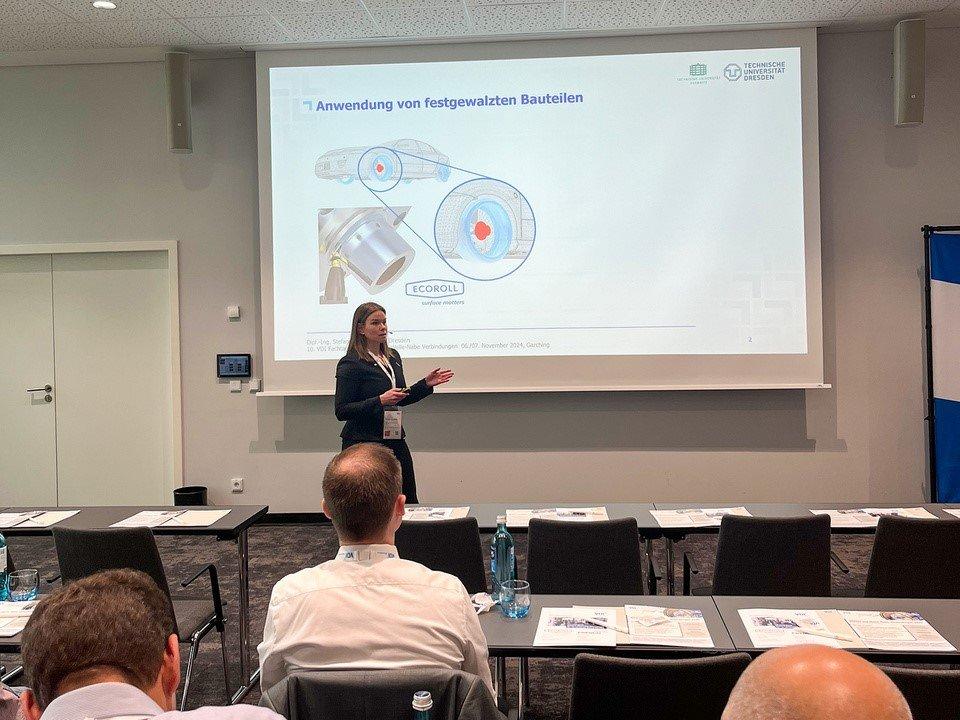Manufacturing processes such as deep rolling allow to introduce compressive residual stresses in a targeted manner, particularly in the highly stressed near surface areas. These counteract load stresses and thus improve fatigue strength.
Two essential conditions must be met in order to make targeted use of this effect. Firstly, when designing the components, it must already be clear how changing near surface properties will affect component performance. And secondly, knowledge of the benefits of deep rolling tools must be available in production.
As part of the above-mentioned FVA project, the research group dealt precisely with the first condition. Today, there are various guidelines for the correct design of shafts and shaft heels. This is a demanding task and requires the designer to make a relatively rough estimate of the effect of the process. The project aimed at improving this estimation and thus giving the designer more certainty when designing components.
The results were presented by Stefanie Günther, project manager and research assistant at the Institute for Machine Elements and Machine Design at the Technical University of Dresden, at the VDI conference "Shaft and Shaft-Hub Connections" in Garching in November 2024.
ECOROLL AG Werkzeugtechnik from Celle was closely involved in the project work for its entire duration and played an active role in the project. Oliver Maiß, Head of Development at ECOROLL AG, is enthusiastic about the diversity of the results: "Within the project, such a broad test matrix was examined as I have never seen before in any other project. The results show that deep rolling practically always achieves an improvement in fatigue strength for different materials, notch geometries and load types."
How notch stresses affect the service life of your shafts
If a notch is deep rolled in a targeted manner, significant increases in service life can be achieved, for example load increases of up to +93%.
During deep rolling, a rolled body is pressed onto the surface of a component. It then rolls off and causes plastic deformation of the surface and the underlying near surface area. The decisive parameters for the process are the geometry of the roller, feed rate and, above all, the rolling force. This determines what level the introduced compressive residual stresses can reach.
Tool selection and process optimization for maximum fatigue strength
There are various tools on the market for deep rolling. These often differ in the geometry of the individual rolling elements. The tool – and in particular the roller – must be matched to the processing task. A roller like the one shown in Figure 2, for example, is not suitable for processing radii and other free-form surfaces. Instead, it is ideal for smoothing cylindrical inner or outer surfaces, as it enables very high feed rates.
Single-roller mechanical tools in which the roller is self-supported are particularly suitable for deep rolling radii. Figure 3 shows, for example, a single-roller mechanical tool of type EG45 with a 40M roller. The roller is directly supported and can absorb axial and radial loads. By positioning the roller at 45°, machining over an angle of 90° is possible. This makes this roller variant very suitable for machining radii on shafts.
The roller can be guided along the contour via the CNC control and thus apply an optimum deep rolling force at any point. However, a special feature of the tool type must be considered when programming. The force is applied in the tool via spring elements that can deflect in one direction; in this case at 45°, i.e. at right angles to the roller axis.
The spring direction must be taken into account when evaluating the rolling force. If a cylindrical surface is machined, the real rolling force becomes the spring force at an angle of 45°. The latter is displayed on the dial gauge. If a constant rolling force is applied over an entire radius, the displayed spring force changes. It would therefore be wrong to program the process in such a way that the dial gauge displays the same value over the entire radius.
ECOROLL AG Werkzeugtechnik
Hans-Heinrich-Warnke-Str. 8
29227 Celle
Telefon: +49 (5141) 9865-0
Telefax: +49 (5141) 881440
http://www.ecoroll.de
Marketing, PR
Telefon: +49 (5141) 986545
E-Mail: markus.boesel@ecoroll.de
![]()
